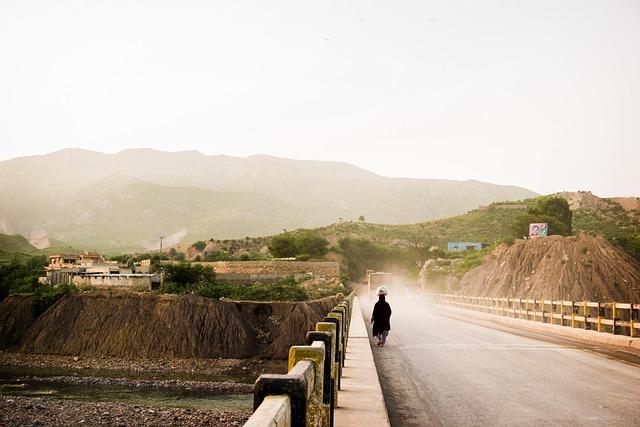Navigating Multidimensional Challenges: Pakistan’s Social Landscape
Nestled between ancient mountains and bustling urban centers, Pakistan is a tapestry woven with rich cultural threads, historical complexities, and vibrant social dynamics. As the nation strides deeper into the 21st century, it finds itself at a crossroads, confronting a multitude of challenges that span economic disparities, educational inequalities, political tumult, and the ever-present specter of extremism. This article embarks on an exploratory journey through Pakistan’s multifaceted social landscape, unearthing the intricate patterns that define its identity and the myriad forces at play. By examining the interplay between tradition and modernity, opportunity and adversity, we seek to illuminate the pathways that individuals and communities navigate in their quest for progress and stability. As we delve into the heart of Pakistan’s diverse society, we aim to foster a deeper understanding of the triumphs and trials that characterize this nation, revealing not just the challenges that lie ahead, but also the resilience and innovation that emerge in response.
Understanding Socioeconomic Disparities and Their Impacts on Communities
In Pakistan, the landscape of socioeconomic disparities reveals a complex web of challenges that profoundly impact communities across the nation. These disparities can be attributed to a variety of factors, including education, income inequality, access to healthcare, and employment opportunities. For instance, urban centers often offer more advantages such as better educational institutions and healthcare facilities, while rural areas may struggle with limited resources. This divide perpetuates a cycle of poverty, where underprivileged groups find it increasingly difficult to improve their living conditions. To illustrate this point, the following list highlights key areas affected by socioeconomic disparities:
- Education: Limited access to quality education in disadvantaged regions.
- Healthcare: Insufficient medical facilities leading to higher morbidity rates.
- Employment: Scarcity of job opportunities, particularly in rural areas.
- Infrastructure: Poor infrastructure exacerbating isolation and economic stagnation.
Addressing these disparities is crucial for fostering inclusive growth and ensuring that all segments of society can thrive. Initiatives aimed at improving educational access, providing healthcare services, and enhancing economic opportunities can pave the way for a more equitable society. A recent analysis of socioeconomic indicators illustrates the stark differences between provinces:
| Province | Literacy Rate (%) | Unemployment Rate (%) | Per Capita Income (PKR) |
|---|---|---|---|
| Punjab | 60 | 5.5 | 42,000 |
| Sindh | 55 | 7.0 | 39,500 |
| Khyber Pakhtunkhwa | 50 | 8.5 | 35,000 |
| Balochistan | 45 | 10.5 | 30,000 |

Bridging Educational Gaps: Strategies for Inclusive Learning
In the quest for equitable education, embracing a multiplicity of strategies is essential. Teacher training stands at the forefront, equipping educators with the skills to recognize and address diverse learning needs. Furthermore, creating adaptive curricula that reflect local cultures and languages fosters engagement among students. Use of assistive technologies serves as a bridge for children with disabilities, allowing them to participate fully in classroom activities. These strategies not only enhance educational accessibility but also promote a sense of belonging, which is vital in a heterogeneous society.
Collaboration between various stakeholders is crucial in this endeavor. Schools must engage with local communities and parent organizations to understand the unique challenges faced by students. Establishing mentorship programs can provide support and guidance, ensuring that learners from underprivileged backgrounds are not left behind. To visualize the impact of these strategies, consider the table below, showcasing key initiatives that have made significant strides in inclusivity:
| Initiative | Description | Impact |
|---|---|---|
| Teacher Training Workshops | Empowering educators with the tools for inclusive practices. | Increased student engagement and understanding. |
| Community Learning Centers | Providing supplementary education resources in local languages. | Enhanced literacy rates in marginalized communities. |
| Assistive Technologies | Implementing tech solutions like audio books and interactive content. | Improved participation for students with disabilities. |

Empowering Women and Marginalized Groups: Fostering Social Equity
In the quest for social equity, the empowerment of women and marginalized groups in Pakistan is more than an objective; it is a necessity for national progress. Investing in education and vocational training not only equips these individuals with the skills needed for economic independence but also challenges the prevailing societal norms that often restrict their potential. By promoting gender-sensitive policies and ensuring equal access to resources, communities can foster an environment where voices traditionally silenced gain the opportunity to speak and contribute actively.
Additionally, community initiatives aimed at fostering collaboration can serve as a catalyst for change. Grassroots organizations play a pivotal role in identifying and addressing the specific needs of these groups. Through the establishment of support networks, these organizations can offer:
- Access to microfinance
- Legal assistance for rights protection
- Health education and services
Furthermore, by engaging local leaders and influencers in awareness campaigns, the societal stigma surrounding marginalized communities can be systematically dismantled. The table below illustrates the impact of these initiatives:
| Initiative | Benefit | Community Impact |
|---|---|---|
| Vocational Training Programs | Skill Development | Increased Employment Rates |
| Microfinance Support | Financial Independence | Reduced Poverty Levels |
| Awarenes Campaigns | Social Acceptance | Strengthened Community Cohesion |

Harnessing Technology for Community Development and Civic Engagement
In the face of complex challenges, technology emerges as a powerful catalyst for change in Pakistani communities. Mobile applications and social media platforms have become essential tools for fostering civic engagement, enabling citizens to connect, share ideas, and mobilize for action. Local organizations are leveraging these platforms to disseminate vital information, organize community events, and streamline communication channels. This not only enhances awareness but also empowers marginalized voices to participate in societal dialogue. As a result, there’s a growing wave of digital activism that encourages young people to engage with pressing social issues, from education to health care.
Moreover, innovative tech solutions like online platforms for community feedback and crowdsourcing initiatives are proving instrumental in bridging gaps between citizens and local authorities. These tools facilitate real-time feedback on public services, enabling residents to voice their concerns directly. To further illustrate the impact of technology on community development, consider the following table showcasing key digital initiatives in Pakistan:
| Initiative | Description | Impact |
|---|---|---|
| Citizen Feedback Model | A platform for real-time input on government services | Increased transparency and responsiveness |
| Digital Literacy Programs | Training initiatives to enhance tech skills | Empowerment through knowledge and skill development |
| Online Community Platforms | Spaces for community discussions and planning | Strengthened community bonds and collective action |
Concluding Remarks
as we navigate the intricate web of Pakistan’s social landscape, it becomes evident that the challenges faced are as multidimensional as they are profound. From the rich tapestry of cultural diversity to the pressing concerns of economic disparity, each thread weaves a narrative of resilience and complexity. Understanding these dynamics requires a nuanced perspective that respects the history, acknowledges the present, and envisions a future grounded in collaboration and innovation.
As we look ahead, the path forward will demand not only insight but also action—a concerted effort to bridge divides and embrace the multifaceted nature of society. The journey of Pakistan, marked by both struggles and triumphs, holds lessons that resonate far beyond its borders. By fostering dialogue and building connections, we can illuminate the way toward a more inclusive and harmonious future.
Thus, as we untangle the layers of challenges and opportunities, let us remain mindful of the importance of empathy and engagement. In recognizing and valuing the diverse experiences that shape Pakistan, we may find the seeds of transformation that will nurture a brighter, more unified tomorrow.



